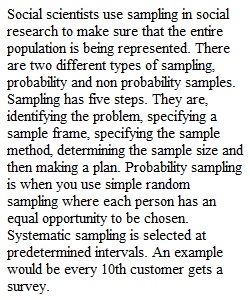


Q Purpose: The purpose of this check-in is for you to demonstrate you have mastered the concepts in this module. Task: 1. Answer the following question in complete sentences. Your answer should be approximately 200 words, 2-3 paragraphs, or a full-page double spaced. 2. Upload your answer in doc, docx, or pdf format (no google docs, no pages). Why do social scientists use samples in social research? Describe what makes a sample a probability or non-probability sample. Identify and explain the sampling procedures for three different types of samples (at least one probability sample). Using students from Curry as your population, describe how you would select a sample of students using these techniques Criteria: Use the rubric provided to guide your answers. • o Be sure to address ? Describe probability sampling and non-probability sampling ? Describes procedures for three sampling methods ? Able to apply the techniques to practice. ? Explains three sampling techniques in real life. Rubric Check-In #4 Check-In #4 Criteria Ratings Pts This criterion is linked to a Learning OutcomeSampling - C level Describe sampling and explain its purpose and importance in social research threshold: 4.0 pts 5 pts Exceeds 4 pts Meets 3 pts Mostly meets 2 pts Some indication it meets 1 pts Does Not Meet 0 pts Ungradeable 5 pts This criterion is linked to a Learning OutcomeSampling - B level Identify sampling techniques threshold: 4.0 pts 5 pts Exceeds 4 pts Meets 3 pts Mostly meets 2 pts Some indication it meets 1 pts Does Not Meet 0 pts Ungradeable 5 pts This criterion is linked to a Learning OutcomeSampling - A level Critique a sampling technique threshold: 4.0 pts 5 pts Exceeds 4 pts Meets 3 pts Mostly meets 2 pts Some indication it meets 1 pts Does Not Meet 0 pts Ungradeable 5 pts Total Points: 15
View Related Questions